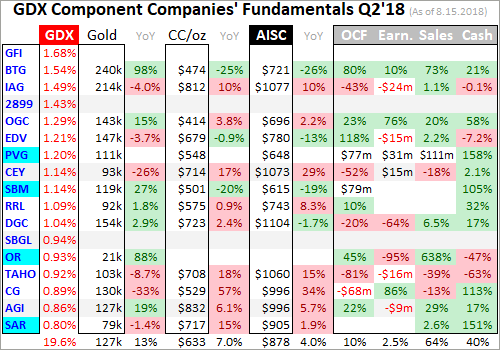The major gold miners’ stocks plummeted in brutal cascading selling this week as stops were run. That shattered strong multi-year support, devastating sentiment among the handful of contrarians remaining in this forsaken sector. With fear and despair extreme, it’s critical to take a deep breath and get grounded in the gold miners’ just-reported Q2’18 fundamentals. They reveal if this surprise anomalous plunge was justified.
Four times a year publicly-traded companies release treasure troves of valuable information in the form of quarterly reports. Companies trading in the States are required to file 10-Qs with the US Securities and Exchange Commission by 45 calendar days after quarter-end. Canadian companies have similar requirements. In other countries with half-year reporting, many companies still partially report quarterly.
The definitive list of major gold-mining stocks to analyze comes from the world’s most-popular gold-stock investment vehicle, the GDX VanEck Vectors Gold Miners ETF. Its composition and performance are similar to the benchmark HUI gold-stock index. GDX utterly dominates this sector, with no meaningful competition. This week GDX’s net assets are 33.4x larger than the next-biggest 1x-long major-gold-miners ETF!
GDX is effectively the gold-mining industry’s blue-chip index, including the biggest and best publicly-traded gold miners from around the globe. GDX inclusion is not only prestigious but grants gold miners better access to the vast pools of stock-market capital. As ETF investing continues to rise, capital inflows into leading sector ETFs require their managers to buy more shares in underlying component companies.
GDX’s component list this week ran 49 “Gold Miners” long. While the great majority of GDX stocks do fit that bill, it also contains gold-royalty companies and major silver miners. All the world’s big primary gold miners publicly traded in major markets are included. Every quarter I look into the latest operating and financial results of the top 34 GDX companies, which is just an arbitrary number fitting neatly into these tables.
That’s a commanding sample, as GDX’s 34 largest components now account for a whopping 91.7% of its total weighting! These elite miners that reported Q2’18 results produced 241.0 metric tons of gold, which accounts for fully 28.8% of last quarter’s total global gold production. That ran 835.5t per the recently-released Q2’18 Gold Demand Trends report from the World Gold Council. I’ll discuss production more below.
Most of these top 34 GDX gold miners trade in the US and Canada where comprehensive quarterly reporting is required by regulators. But some trade in Australia and the UK, where companies just need to report in half-year increments. Fortunately, those gold miners do still tend to issue production reports without financial statements each quarter. There are still wide variations in reporting styles and data offered.
Every quarter I wade through a ton of data from these elite gold miners’ latest results and dump it into a big spreadsheet for analysis. The highlights make it into these tables. Blank fields mean a company had not reported that data for Q2’18 as of this Wednesday. Looking at the major gold miners’ latest results in aggregate offers valuable insights on this industry’s current fundamental health unrivaled anywhere else.
The first couple columns of these tables show each GDX component’s symbol and weighting within this ETF as of this week. While most of these stocks trade on US exchanges, some symbols are listings from companies’ primary foreign stock exchanges. That’s followed by each gold miner’s Q2’18 production in ounces, which is mostly in pure-gold terms. That excludes byproduct metals often present in the gold ore.
Those are usually silver and base metals like copper, which are valuable. They are sold to offset some of the considerable costs of gold mining, lowering per-ounce costs and thus raising overall profitability. In cases where companies didn’t separate out gold and lumped all production into gold-equivalent ounces, those GEOs are included instead. Then production’s absolute year-over-year change from Q2’17 is shown.
Next comes gold miners’ most-important fundamental data for investors, cash costs and all-in sustaining costs per ounce mined. The latter directly drives profitability which ultimately determines stock prices. These key costs are also followed by YoY changes. Last but not least the annual changes are shown in operating cash flows generated, hard GAAP earnings, sales, and cash on hand with a couple exceptions.
Percentage changes aren’t relevant or meaningful if data shifted from positive to negative or vice versa, or if derived from two negative numbers. So in those cases, I included raw underlying data rather than weird or misleading percentage changes. This whole dataset together offers a fantastic high-level read on how the major gold miners are faring fundamentally as an industry. Was this week’s plummeting righteous?


This ongoing quarterly post-earnings-season project to better understand how the gold-mining industry is actually faring fundamentally is tedious and time-consuming. The best insights don’t emerge until all the research is complete, as the big picture is more illuminating than individual companies’ results. As I was doing much of this work this week, the plummeting gold-stock prices cast a dark psychological pall over everything.
I always start at the top of GDX’s component list and gradually work my way down, examining the latest quarterly filings from each company. Early on I was shocked by the sharp annual production declines at the world’s biggest gold miners! Newmont Mining and Barrick Gold have run neck-and-neck as the top gold miners for long decades now. Compared to most other gold miners, their resources may as well be unlimited.
They have diversified portfolios of gold mines across continents and many countries, and deep pipelines of exploration projects and new-mine builds. NEM and ABX pour vast amounts of capital into maintaining their gold production as existing mines are depleted. The major gold miners hate reporting declines in production, as investors punish stocks for it with sizable selling. It is seen as signaling deteriorating health.











Leave A Comment